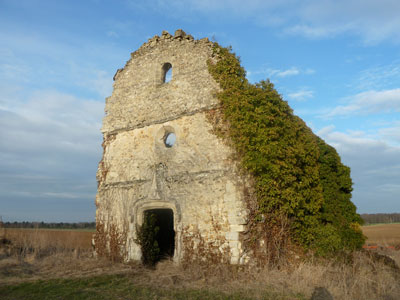
Sentiers du Patrimoine ®
Chaussy

Après les ruines de la Chapelle, emprunter le premier chemin à droite. Descendre toujours tout droit. A la bifurcation au niveau des hangars prendre à droite jusqu’au lavoir à Paulin.
Lavoir à Paulin
Prochain point : lat="49.120199" lon="1.696543"

This grand architectural complex was built in several different stages. The chapel, the dovecote and the Méré tower are the most ancient parts still standing today. They were erected in the 15th century by Guillaume Pillavoine, lord of Villarceaux. The Méré tower is a six-story circular plan building, with a cone-shaped roof. It was listed as a historical monument in 1927. It includes an external staircase tower. In 1819, the tower was part of a farm, which has since disappeared. It retains its original staircase and part of its curtain wall, showing it was once used for defensive purposes. The wall is 90 to 95 cm thick. The complex also includes a square courtyard, built in the 19th century, a three story residence and some barns, including one supported by cut stone buttresses and a circular plan dovecote (dating back to 1415).
Some structures date back to the time when the property was owned by the famous jeweller and watchmaker Louis Cartier. For example, his initials (C.L.) can be found over the entry gate (restored in 1869) and on the barn on the right side of the courtyard, which dates back to 1874.
The Saint-Laurent chapel is one of the last remnants of the ancient domain of the Méré manor. This single-nave chapel was built in 1474 for a brotherhood of monks. In 1822, the interior and roof were destroyed by arson. Only the external walls remained, with a few window openings and the Western entryway. Its elliptical arch is decorated with mouldings sculpted into the stone and topped with a gable adorned with a shield and reed. According to the 1819 land registry, the edifice was once supported by six buttresses and had a three-sided apse. Traces of ochre paint recall the décor and function of this sanctuary, which was likely once panelled. Its bell is now in Chaussy church. The ruins of the chapel were listed as a historical monument in 1950.


